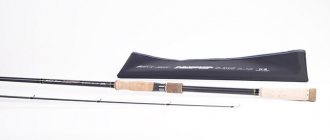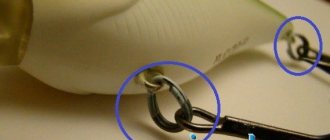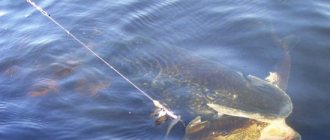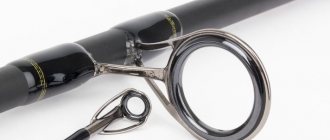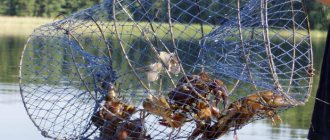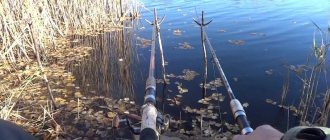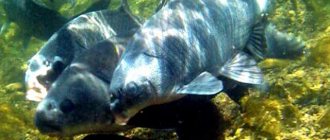General description of fish
Crucian carp has an oblong and slightly rounded body shape. The body is flattened on the sides and covered with smooth scales. Life expectancy depends on the species and living conditions.
Crucian carp in English : crucian, carp, crucian carp, goldfish.
What order, family, class, group of fish does it belong to?
Crucian carp is a representative of the order Cyprinidae and the family Cyprinidae.
What it looks like, color and size
The color of crucian carp depends on the species. It can vary from different shades of silver to gold. The fish has a rather wide back and a high dorsal fin.
The maximum length of an adult is 50−60 cm. Weight depends on the type of crucian carp. The head is small with a small mouth and eyes. A distinctive feature of this kind is the presence of jagged rays in the anal and dorsal fins. The caudal fin is forked.
Internal structure
The biological difference between crucian carp species lies in the number of gill rakers on the gill arch. For example, the silver species has 39–50 stamens, and the golden species has 23–33 stamens. They are needed to purify water.
The size of the stamens determines how fine the food can be filtered and sent into the esophagus.
The lateral line is important. It allows the fish to sense almost imperceptible air vibrations that are created by the insects on which it feeds. Crucian carp is able to detect such vibrations at a distance of up to half a meter.
Fish has well-developed taste organs. They are located not only in the mouth, but also on the head. To evaluate the taste of the nozzle, she may not even put it in her mouth.
Heart
The heart is located behind the gill covers and pumps blood throughout the body. Fish have only one circulation, oxygen comes from the water through the gills. In the gills, blood flows through thin capillaries.
Fish intestines
Crucian carp feeds mainly on plant foods, so it has a long intestine. Its size exceeds the body length by 9−13 times. For example, in an omnivorous carp, the intestine is only 2-3 times longer than the body.
How many chromosomes does he have
There are several forms of crucian carp. The first is represented by females and males, the second - only females. Outwardly, they are no different from each other. The difference lies in the number of chromosomes, which can only be determined using a genetic method.
The bisexual form has 100 chromosomes, and the unisexual form has about 156 pieces.
Fish scales
The scales are quite large and smooth. Due to the fact that it does not adhere tightly to the skin, it is quite easy to get rid of it.
What color is caviar
The color of caviar may vary. The shade can vary from dark gray, green to light yellow.
How does crucian carp differ from carp, carp and buffalo?
Crucian carp is a member of the carp family, but at the same time it has a large number of distinctive characteristics.
IMPORTANT. It is quite simple to distinguish crucian carp from carp by appearance - carp have a mustache.
This fish has meatier and thicker lips. The body of the crucian carp is compressed on the sides; the carp has a simply elongated body, covered with light scales. Carp meat has a pinkish-red hue and a minimal amount of bones, while crucian carp is distinguished by white meat and bonyness. Carp is a close relative of crucian carp, but its size can be 2-3 times larger. This fish is distinguished by the presence of two pairs of small whiskers. The meat of carp is not as bony as that of crucian carp. Unlike crucian carp, carp can live up to 35 years.
Buffalo fish have fleshy lips that are covered with small hairs. It is quite large in size. Some individuals can grow up to 20 kg, with a length of 125 cm. Buffalo is not as bony as crucian carp.
The difference between crucian carp and carp
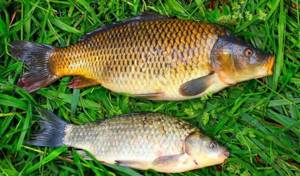
There is no doubt that an experienced fisherman will be able to distinguish these fish without any problems. But some difficulties may arise for beginner fishermen. Let's try to understand the similarities and differences.
Both types of fish belong to the same family and have similarities, for example:
- Colors,
- Massive body;
- Large scales;
- Fin color and size.
All these similarities can be identified, rather at a superficial glance. If you look more closely, the differences become more obvious.
The main differences between these fish include the following:
- The dorsal fin of the carp is noticeably longer, but less in height.
- The body of the carp is somewhat elongated, while the crucian carp, especially the golden one, is more round in shape.
- The presence of mustaches in carp
- The weight of an adult carp is several times greater
Additional differences:
Carp Crucian carp
Hump on the nose Straight contours of the head Fleshy lips Thin lips The body is full, elongated, flexible The body is tall, compressed Dark, large scales The scales are lighter, smaller, harder Notch on the fin Smooth fin Larger and heavier Smaller, lighter
We recommend reading: Winter carp fishing: choosing gear and fishing tricks
Varieties
The genus of crucian carp consists of a large number of species. Each of them has its own distinctive characteristics and habitat.
Gold
The golden crucian carp has a convex edge on the dorsal fin. Unlike other species, this one has a rounded head shape. Often found in swampy lakes.
The scales can be copper, bronze or completely gold. There is no pigmentation on the abdominal part, the back has a brown tint.
REFERENCE. During the winter, representatives of the golden species fall into a sleepy state and hide in the mud.
Thus, they can survive frosts even if the lake is completely covered with ice. This is a fairly tenacious species. There have been cases when crucian carp was dug up at a depth of 70 cm in an overgrown pond, while it was still alive.
The basis of the diet is aquatic vegetation. Often individuals of this species can sink into mud, where there is a large amount of organic debris. In reservoirs with a sandy bottom, golden crucian carp grows very slowly.

Silver
The silverfish has a large number of differences from the standard goldfish. It has a long dorsal fin that is curled inward. All teeth are pharyngeal and single-row.
IMPORTANT. Initially, this species was found only in the waters of the Pacific Ocean.
Due to artificial resettlement, such fish were introduced into the waters of China, North America, Siberia, Ukraine, Lithuania and Poland.
The silver variety has larger scales. Its color can be silver-gray. Sometimes there are individuals with a rather uncharacteristic color - pinkish-orange scales.
The fins can be completely transparent with a gray or olive tint. The maximum weight of such individuals is 3 kg, and the length is 40 cm.
gold fish
Goldfish is a type of crucian carp that has a large number of subspecies. Most of them are intended for breeding in an aquarium. Representatives of this species differ not only in color, but also in shape and size.
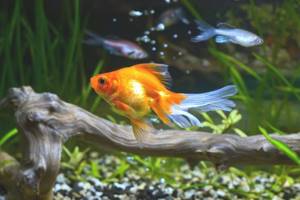
The length of such a fish can vary from 2 to 45 cm. A variety of colors are possible, which includes all the colors of the rainbow. The body shape can be elongated, spherical or ovoid.
REFERENCE. The fins and tail can be either short or very long.
In which species the fins may resemble wings or a light veil. The eyes are small and protruding.
Sea crucian carp
The marine species of crucian carp has an elongated body. Color - yellow. The ventral part is lighter and has a silvery tint. The back is darker. A peculiarity of the marine representatives of the genus is the presence of a dark spot near the caudal fin.
Sea crucian teeth are arranged in several rows. The first row is the wide incisors, the second row is the chewing teeth. The maximum length of an adult is 30 cm. Weight is small, about 1 kg. Sometimes there are individuals weighing 1.5 kg.
Such an individual has several sharp rays near the anal fin. They allow you to protect yourself from predators. Having caught such a fish, you need to carefully remove it from the hook, as you can get pricked by its rays.
Chinese
The Chinese variety of crucian carp was artificially bred from the golden species. This fish can grow up to 32 cm in length. The basis of its diet is invertebrates and plankton. An important condition for breeding is cool water.

Black Sea
The Black Sea type does not have any special differences from freshwater representatives. Found in the Black and Azov Seas, very rarely swims into warmer waters. To catch it, mussels, shrimp, worms or pieces of fresh fish are used.
Japanese
The Japanese species of crucian carp is found in the waters of Japan and Taiwan. The length of such fish varies from 35-40 cm. Wild species live in the Japanese Lake Biwa.
Mirror
This is one of the trophy species of crucian carp. Its homeland is Germany; over time, the fish spread throughout all European waters. Its peculiarity is the minimal amount of scales. It has a round, humpbacked body and a large head.
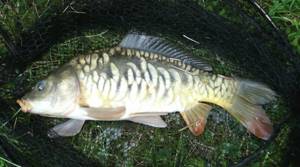
Bolotny
Swamp crucian carp has an elongated body and small size. The distribution area is small forest swamps. A large number of such fish can live in one body of water, so often there is not enough food and they do not grow.
Far Eastern
The Far Eastern species is a type of golden crucian carp. It has a large number of other names: summer resident, sunflower and weatherman. Its distinctive feature is less golden scales. The maximum length can reach 60−70 cm, and the weight can reach up to 7−8 kg.
Initially, the distribution area of the Far Eastern crucian carp was the Amur River and adjacent reservoirs. This species is often used as an object for sport and recreational fishing.
African
African freshwater fish from the carp family is found in the waters of Central and Northern Africa. Most often it can be found at medium depths or closer to the bottom. It has an elongated body and large scales. It can grow up to 70 cm and weigh up to 5 kg.
Amursky
Amur crucian carp is the same Far Eastern species. It has a high reproductive capacity. This fish quickly adapted to living in fisheries and cultural ponds, and then quickly and spontaneously spread to other bodies of water.
Some representatives live not only in bodies of water without a current, but also in the estuarine areas of rivers.
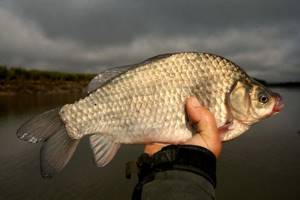
Azov
Azov crucian carp is a marine species that is also found in the Black Sea. It has all the features of an ordinary sea crucian.
The best places to live
The range of this undemanding and unpretentious fish is extensive; it is capable of living even in a small hole, where another species would certainly die. It has been noticed that when the conditions of a reservoir deteriorate, there is a lack of oxygen and it becomes overgrown with silt, its inhabitants become more comfortable - they swim faster and reproduce more successfully . Places where crucian carp live:
- swampy rivers,
- muddy ponds,
- overgrown low-lying lakes.
These hardy and tenacious inhabitants of the depths adapt even to the conditions of an artificial reservoir formed after mining and flooding of a quarry. But it is very difficult for crucian carp fish to get used to the cold and clean waters of mountain rivers and lakes, and sometimes they cannot. Nevertheless, the spread of the species has even reached the harsh Kolyma: under extreme conditions of drought or severe frost, crucian carp burrow into muddy soil up to 70 cm and wait out the difficult period. In winter they hibernate and survive when the water freezes completely.
Behavior
The behavior of fish depends on the reservoir and time of year. If this is the only dominant species in the reservoir, then it will bite quite greedily and boldly, regardless of the bait. In this case, there is a risk that the crucian carp will degenerate into a dwarf form.
In lakes and other bodies of water where carp, tench or rudd are present, the weight of the crucian carp will be much greater.
At the same time, he will peck on both plant and animal bait. Only large individuals are able to actively move around a body of water, while violating all boundaries.
IMPORTANT. If a fish is adjacent to a predator, then it becomes much more careful.
At the same time, its weight and length can reach maximum dimensions.
In spring, fish begin their seasonal migration. It begins to behave more actively as soon as the ice melts and the water is saturated with oxygen. The fish unite in groups and move to shallow lagoons, where the water warms up the fastest. Spawning occurs together with roach.
In summer, crucian carp is practically motionless, since there is enough food and it does not need to waste energy searching for it. The second spawning period begins in June.
The end of summer - the beginning of autumn is the period when fish begin to actively move to deeper parts of the reservoir, as close as possible to the wintering holes.
Habitats
Crucian carp is an unpretentious species of fish, so it has a fairly wide distribution area. It can often be found in the following bodies of water:
- rivers;
- ponds;
- lakes;
- swampy bodies of water.
Scientists point out that the more silt there is in a reservoir, the more comfortable the crucian carp will feel. During severe frosts, fish can sink down to 70 cm.
REFERENCE. This species is not found in mountain rivers and lakes.
Thanks to human economic activity, crucian carp lives in water bodies of many countries. It is distributed in the following areas:
- Russia;
- China;
- Mongolia;
- Korea;
- Poland;
- Italy;
- Germany;
- Portugal;
- Hungary.
Some species are found in the cold waters of Siberian rivers. Representatives of this species also live in the waters of Thailand, India, the USA and Pakistan.
Does crucian carp bury itself in mud?
For a comfortable winter, crucian carp buries itself in silt, in which it waits out the cold winter. In this case, the fish survives even if the lake freezes completely to the very bottom. Crucian carp can also burrow into silt during severe drought, when the reservoir almost completely dries up.
What does it eat?
Crucian carp feed on underwater vegetation, zooplankton and small invertebrates. In the absence of sufficient food, it can even consume organic waste.
In the first week after birth, the fry feeds on the contents of its gall bladder. A week later he begins to consume simple microorganisms.
IMPORTANT. The fry's diet is based on bacteria, algae and daphnia.
Only after a month does the fish begin to eat more nutritious food. These can be larvae of water insects and bloodworms.
Adults feed on:
- worms;
- insect larvae;
- cariform;
- root part and stems of plants;
- algae;
- duckweed
If fish is grown for commercial purposes, then its diet may include bread crumb, porridge and dough.
Carnivore or herbivore
Crucian carp does not eat other fish. The main part of the diet is plant foods.
food chain
Such fish are present in the following food chain: algae - crustaceans - crucian carp - pike.
Fish diseases
There are quite a large number of diseases that crucian carp can suffer from. Some of them can be dangerous to humans. Main diseases:
- ligulosis;
- opisthorchiasis;
- rubella;
- ichthyophthyriosis.
Among the cyprinids, a disease such as ligulosis is widespread. It is provoked by the presence of plerocercoids of Ligula intestinalis. They can be located in the peritoneum of the fish, thereby causing atrophy of the internal organs.
Affected fish may become infertile and the abdominal cavity often ruptures, leading to death.
The causative agents are helminths that can grow from 5 to 120 cm in length. They are able to exist in fish for 3 years.
The disease opisthorchiasis is quite dangerous for humans. It occurs due to infection by helminths. In this case, the pancreatic ducts, gall bladder and liver ducts are affected. Crucian carp acts as an additional host.
Sources of invasion are people, wild and domestic animals.
IMPORTANT. Rubella occurs in almost all representatives of cyprinids, including crucian carp.
The disease occurs in late spring or early summer. Sometimes the lesion can occur in winter. Most often, individuals 2-3 years old get sick. Rubella can cause mass mortality.
In acute cases of the disease, hemorrhages, dropsy, ruffling of the eyes and bulging eyes are observed. In the chronic form of the disease, ulcers form on the skin of the fish.
Ichthyophthiriasis is the second most dangerous disease after rubella. Most often it occurs in young individuals. The disease is transmitted from a parasite that lives under the skin of crucian carp. The affected fish becomes lethargic and does not respond to any stimuli.
Crucian carp is susceptible to many diseases. During economic breeding, most of them are easily eliminated with the help of special preparations.
Nutrition of crucian carp
We can say that crucian carp eat a variety of foods and will not refuse either cereals or organic animal food. True, you can’t force the fish to eat the crucian carp, unless very large specimens can swallow the fry. But all relatively peaceful fish are guilty of this. As a newborn fry, crucian carp eats what was given to it from birth - the contents of the yolk sac. Grown-up crucian carp begin to eat various algae, mostly microscopic blue-green algae. Daphnia is also included in their diet. Next, various larvae, bloodworms, and worms are eaten. Larger individuals introduce crustaceans and mollusks into their diet. Crucian carp will not refuse bread and various cereals to which fishermen have accustomed them.
Development and reproduction
Sexual maturity of crucian carp occurs at 3-4 years of age. With plenty of feeding, the fish can become mature as early as 2 years. In the northern regions, sexual maturity occurs several years later.
Crucian carp spawn at water temperatures above 14 °C. Optimal values are 17−18 °C. The female lays eggs in several approaches, the interval between which can be up to 10 days. The spawning itself is quite drawn out. It starts in May and ends only in August.
REFERENCE. Crucian carp can spawn about 300 thousand eggs at a time, and silver carp - up to 400 thousand.
The process of reproduction of crucian carp itself is practically no different from the reproduction of other spawning fish. Females lay eggs, and males fertilize them with milk. The eggs attach to the stems of aquatic vegetation and develop within a week.
Stages of development
Development begins with the adult laying eggs and milk. External fertilization takes place and an embryo is formed. Then a larva emerges, and from it a fry. Over time, it grows into an adult and the chain of development repeats itself.
Caviar development
For normal development of eggs, an optimal water temperature is required - above 14 degrees. It will not develop in a hole. After fertilization, a certain amount of time is required for the incubation period.
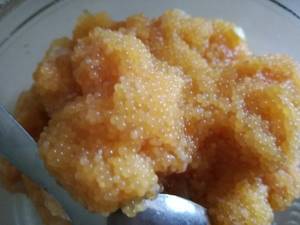
On average, embryos appear in 3 days; in warm water the process occurs faster. The hatched larva is about 4 mm long. Closer to autumn it grows to 5-8 cm.
What affects growth
The growth of fish depends on many factors. It will develop faster in the most comfortable conditions and with enough food. It should be remembered that crucian carp prefers muddy reservoirs.
They contain a large number of small microorganisms that it feeds on.
How long does he live?
Life expectancy depends on the variety of crucian carp. The silver type can live up to 8-9 years, in almost any body of water. This species is distinguished by greater vitality and fertility. Representatives of the golden crucian species live on average about 12 years.
Weight Limit
In industrial conditions, the weight of crucian carp can be about 500 g. Under favorable growing conditions, such fish can gain weight up to 5 kg.
The largest crucian carp in the world caught on a fishing rod
There are many versions regarding the weight of the largest crucian carp in the world. According to one of them, the largest fish was caught by an Englishman. She weighed 42.6 kg. Some experts point out that it was not pure crucian carp, but a hybrid with carp.
The largest in Russia
The maximum weight of crucian carp was recorded in the Pskov region in the village of Osyno. A crucian carp was caught with a length of 54 cm and a weight of 5.6 kg.
How to distinguish the sex of a fish
Females grow much longer than males. They are large in size and can produce a lot of caviar, since their dimensions are proportional to the size of the genitals. In males such dependence is not observed.
Where does it spawn?
Spawning occurs in shallow water. The optimal place is thickets of reeds or sedges. Females rub against plants, thereby laying eggs. Silver crucian carp often spawns in bays and reservoirs.
The golden species of fish prefers to lay eggs in still water or with minimal current.
In the pond, fish begin to spawn earlier, since the water temperature in the rivers is lower.
Reproduction (spawning) of crucian carp in a pond
They become capable of reproduction after 5 years. The beginning of spawning coincides with the beginning of spring, falling around the end of May, at which time the water temperature reaches 18 degrees. During the spawning process, there are often breaks that last for weeks. The eggs are very sticky and remain on the vegetation that the fish rub against during spawning. The color of the caviar is predominantly yellow. The female has a unique feature. In the absence of males, she is capable of spawning with other representatives of cyprinids. As such, fertilization does not occur, which leads to the birth of exclusively females.
Catching
In order for crucian carp fishing to be successful, it is important not only to know what bait to catch it with, but also to understand its basic habits. It is best to go fishing with a large number of different baits. It is recommended to take:
- worms;
- corn;
- maggots;
- makuhu.
If the bite on one bait has stopped, then it can simply be changed. This fish loves good smells. Homemade sunflower oil, thyme or roasted cake can be mixed into the bait.
REFERENCE. Crucian carp is a rather shy fish, so it can often hide in reeds or other coastal vegetation.
It is also important to correctly determine the time of fish activity. It will be good to catch in the morning before 11 o'clock and in the evening after 5 o'clock.
Fishing depending on the time of year
Depending on the time of year, fishing techniques change. In spring, crucian carp becomes quite active and is in search of high-calorie food. Worms are best suited for fishing at this time.
In the summer, after the end of spawning, the fish are quite selective in food. It is quite difficult to take, so the bait must be treated with a special flavor. It should have a persistent and pleasant smell. It could be vanilla.
In the first months of autumn and before the onset of cold weather, you can continue fishing. In this case, you can use summer bait. In September, crucian carp bite well throughout the day. With the arrival of cold weather, it is recommended to change the bait to something more nutritious.
Insect larvae or worms are great options. Cumin, dill or coriander can be used as a flavoring.
Catching large crucian carp with a star
To increase your catch, you can use special compounds that make the bait more aromatic. Fish will bite more willingly on such bait. You can use Zvezdochka balm as a flavoring agent. It has a fairly strong aroma, so the fish will be able to find the bait much faster.
IMPORTANT . Due to its thick consistency, the balm will stay on the hook for quite a long time.
Dough, peas, corn or maggots can be used as the main bait. One of the baits can be placed in a special box, pre-lubricated with balm. The asterisk can be applied directly to steamed peas or dough.
How to kill a fish
There are several ways to kill caught fish. This can be done through:
- blow to the head;
- frost;
- vertebral rupture;
- brain piercing.
The most effective and common option is to hit the head with a mallet. It is used in fishing stores. A special mallet is used to stun the fish.
After killing fish in this way, it must be immediately gutted and salted. Otherwise, it starts to deteriorate.
The second option involves freezing. This way the fish is killed and does not spoil. After a few hours it can be taken out and gutted. If you use this method while fishing, you will have to purchase a portable refrigerator.
Few people kill crucian carp by breaking the ridge. This method is quite inhumane and requires certain skills. The worst option is to puncture the brain. In this case, the fish will not die immediately.
Fish farming
You need to start breeding crucian carp by choosing producers. Experienced experts recommend using male goldfish and female silverfish. It is important that the size of same-sex fish is almost the same. It is best to take mature individuals aged 3-4 years.
IMPORTANT. The main requirement when choosing males is the presence of flowing milk.
Until mating, females and males must be kept separate. A sufficient number of plants must be present in the reservoir for spawning.
The larvae appear 4-6 days after spawning; they must remain in the spawning reservoir for the first 3 weeks. After this, the young animals are transplanted to another body of water.
Benefits and harms for humans
Crucian carp meat is beneficial for humans, as it contains a large amount of vitamins and beneficial microelements. Such fish contains a large amount of calcium, which is necessary to maintain the normal condition of bones, teeth and nails.
Crucian carp is a fairly low-calorie fish, so it can be eaten while losing weight. It also contains vitamins A and E. This is an excellent prevention of oncology; vitamins make the body more resistant to infectious lesions.
Harm from such fish only appears if individual intolerance is observed or a low-quality or improperly prepared product was consumed.
Are there worms in fish and what do they look like?
Clays may be present in the body of crucian carp. In most cases, infected individuals can be recognized by their appearance. Such a fish will have minimal muscle and body mass. The look is dull and inexpressive.
A nauseating odor will be felt from the internal organs. If you press on the body of a crucian carp with worms, a hole will form on it, which will not disappear, since its body has already lost its elasticity.
Is it possible to eat fish with worms?
If the fish had worms, but it was cooked in accordance with all standards, it will not pose a threat to humans. There is a risk of infection when eating raw or improperly prepared fish.
In this case, it is recommended to take preventive measures to prevent the development of helminthiasis.
Is there a tapeworm
A tapeworm may be present in the crucian carp. Some anglers believe that if it is removed the fish will be edible and safe. This is true, but only partly, since after removing the tapeworm, its larvae still remain in the body of the fish.
They are almost impossible to notice with the naked eye. When they enter the human body, they begin to actively parasitize. A helminthic infestation can occur without symptoms, but then it leads to serious complications.
Interesting Facts
Crucian carp is a simple fish, but has many interesting habits. In nature, there are only 2 types of such fish: golden and silver. Based on the first, the goldfish was bred.
Fishing for crucian carp is quite unstable. It can bite on completely different baits, so when going fishing you need to take several types. In reservoirs near Moscow you can find a hybrid of golden and silver crucian carp.
REFERENCE. Fish has a good sense of smell.
This must be taken into account when fishing. Some individuals prefer all strange smells that have nothing to do with their usual diet. Sometimes crucian carp are inactive, so experienced fishermen stir up the mud with a stick.
Crucian carp is the most unpredictable fish of all cyprinids. The success of catching such fish does not depend on weather conditions or bait. This fish has a large number of subspecies; not only freshwater and sea crucian carp are found.

